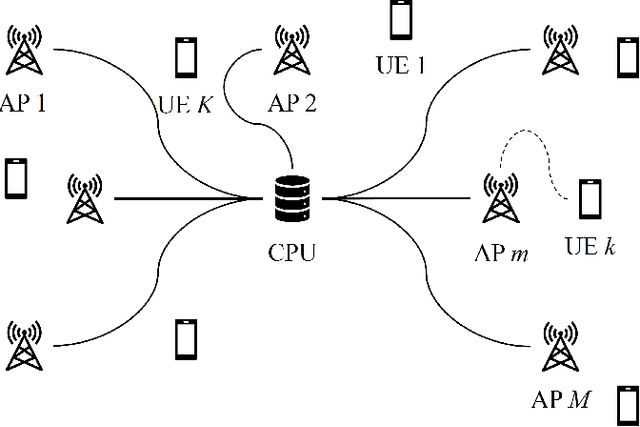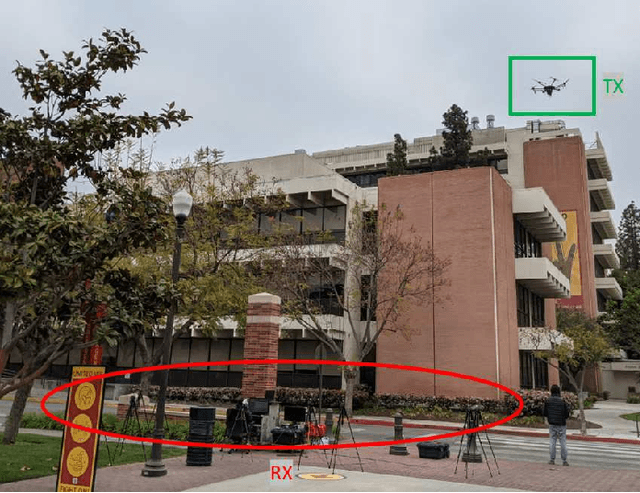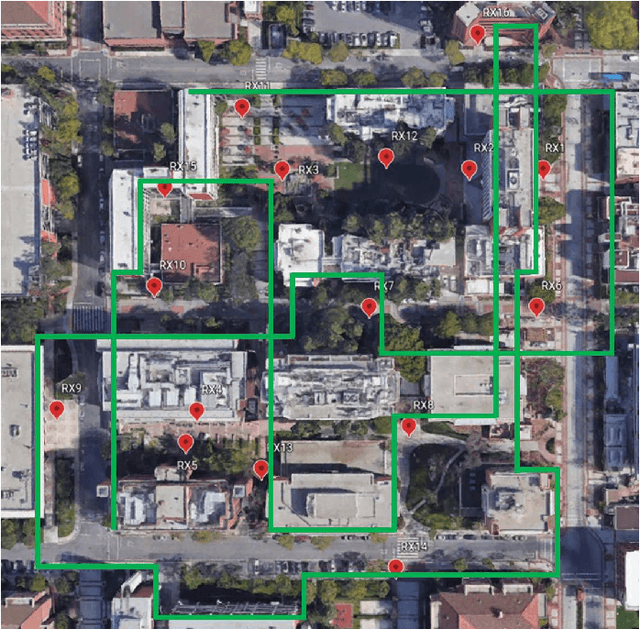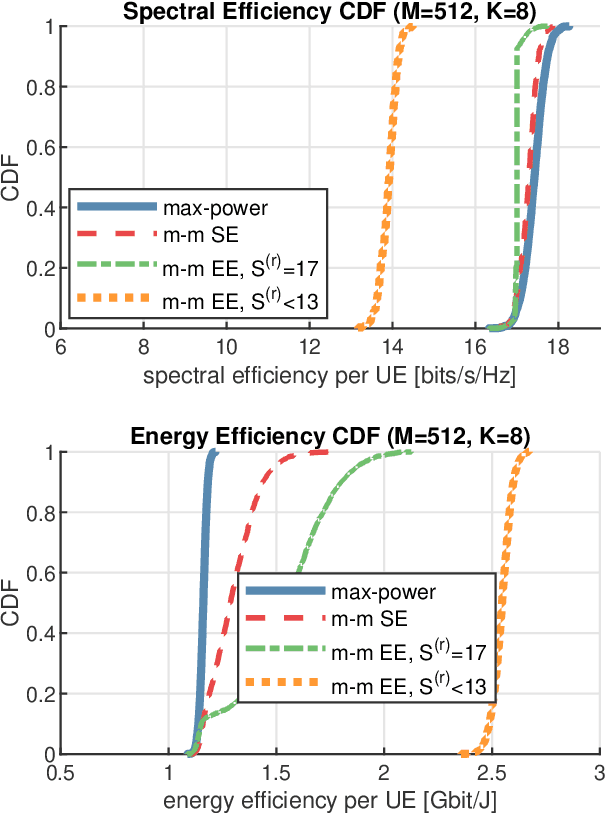Kosuke Yamazaki
User-Centric Clustering Under Fairness Scheduling in Cell-Free Massive MIMO
May 15, 2023Abstract:We consider fairness scheduling in a user-centric cell-free massive MIMO network, where $L$ remote radio units, each with $M$ antennas, serve $K_{\rm tot} \approx LM$ user equipments (UEs). Recent results show that the maximum network sum throughput is achieved where $K_{\rm act} \approx \frac{LM}{2}$ UEs are simultaneously active in any given time-frequency slots. However, the number of users $K_{\rm tot}$ in the network is usually much larger. This requires that users are scheduled over the time-frequency resource and achieve a certain throughput rate as an average over the slots. We impose throughput fairness among UEs with a scheduling approach aiming to maximize a concave component-wise non-decreasing network utility function of the per-user throughput rates. In cell-free user-centric networks, the pilot and cluster assignment is usually done for a given set of active users. Combined with fairness scheduling, this requires pilot and cluster reassignment at each scheduling slot, involving an enormous overhead of control signaling exchange between network entities. We propose a fixed pilot and cluster assignment scheme (independent of the scheduling decisions), which outperforms the baseline method in terms of UE throughput, while requiring much less control information exchange between network entities.
Robust PCA for Subspace Estimation in User-Centric Cell-Free Wireless Networks
Jun 08, 2022

Abstract:We consider a scalable user-centric cell-free massive MIMO network with distributed remote radio units (RUs), enabling macrodiversity and joint processing. Due to the limited uplink (UL) pilot dimension, multiuser interference in the UL pilot transmission phase makes channel estimation a non-trivial problem. We make use of two types of UL pilot signals, sounding reference signal (SRS) and demodulation reference signal (DMRS) pilots, for the estimation of the channel subspace and its instantaneous realization, respectively. The SRS pilots are transmitted over multiple time slots and resource blocks according to a Latin squares based hopping scheme, which aims at averaging out the interference of different SRS co-pilot users. We propose a robust principle component analysis approach for channel subspace estimation from the SRS signal samples, employed at the RUs for each associated user. The estimated subspace is further used at the RUs for DMRS pilot decontamination and instantaneous channel estimation. We provide numerical simulations to compare the system performance using our subspace and channel estimation scheme with the cases of ideal partial subspace/channel knowledge and pilot matching channel estimation. The results show that a system with a properly designed SRS pilot hopping scheme can closely approximate the performance of a genie-aided system.
Optimal User Load and Energy Efficiency in User-Centric Cell-Free Wireless Networks
Jun 08, 2022



Abstract:Cell-free massive MIMO is a variant of multiuser MIMO and massive MIMO, in which the total number of antennas $LM$ is distributed among the $L$ remote radio units (RUs) in the system, enabling macrodiversity and joint processing. Due to pilot contamination and system scalability, each RU can only serve a limited number of users. Obtaining the optimal number of users simultaneously served on one resource block (RB) by the $L$ RUs regarding the sum spectral efficiency (SE) is not a simple challenge though, as many of the system parameters are intertwined. For example, the dimension $\tau_p$ of orthogonal Demodulation Reference Signal (DMRS) pilots limits the number of users that an RU can serve. Thus, depending on $\tau_p$, the optimal user load yielding the maximum sum SE will vary. Another key parameter is the users' uplink transmit power $P^{\rm ue}_{\rm tx}$, where a trade-off between users in outage, interference and energy inefficiency exists. We study the effect of multiple parameters in cell-free massive MIMO on the sum SE and user outage, as well as the performance of different levels of RU antenna distribution. We provide extensive numerical investigations to illuminate the behavior of the system SE with respect to the various parameters, including the effect of the system load, i.e., the number of active users to be served on any RB. The results show that in general a system with many RUs and few RU antennas yields the largest sum SE, where the benefits of distributed antennas reduce in very dense networks.
Subspace-Based Pilot Decontamination in User-Centric Scalable Cell-Free Wireless Networks
Mar 01, 2022



Abstract:We consider a cell-free wireless system operated in Time Division Duplex (TDD) mode with localized user-centric clusters of remote radio units (RUs). Since the uplink pilot dimensions per channel coherence slot is limited, co-pilot users might incur mutual pilot contamination. In the current literature, it is assumed that the long-term statistical knowledge of all user channels is available. This enables MMSE channel estimation or simplified dominant subspace projection, which achieves significant pilot decontamination under certain assumptions on the channel covariance matrices. However, estimating the channel covariance matrix or even just its dominant subspace at all RUs forming a user cluster is not an easy task. In fact, if not properly designed, a piloting scheme for such long-term statistics estimation will also be subject to the contamination problem. In this paper, we propose a new channel subspace estimation scheme explicitly designed for cell-free wireless networks. Our scheme is based on 1) a sounding reference signal (SRS) using latin squares wideband frequency hopping, and 2) a subspace estimation method based on robust Principal Component Analysis (R-PCA). The SRS hopping scheme ensures that for any user and any RU participating in its cluster, only a few pilot measurements will contain strong co-pilot interference. These few heavily contaminated measurements are (implicitly) eliminated by R-PCA, which is designed to regularize the estimation and discount the "outlier" measurements. Our simulation results show that the proposed scheme achieves almost perfect subspace knowledge, which in turns yields system performance very close to that with ideal channel state information, thus essentially solving the problem of pilot contamination in cell-free user-centric TDD wireless networks.
Uplink-Downlink Duality and Precoding Strategies with Partial CSI in Cell-Free Wireless Networks
Jan 17, 2022



Abstract:We consider a scalable user-centric wireless network with dynamic cluster formation as defined by Bj\"ornsson and Sanguinetti. After having shown the importance of dominant channel subspace information for uplink (UL) pilot decontamination and having examined different UL combining schemes in our previous work, here we investigate precoding strategies for the downlink (DL). Distributed scalable DL precoding and power allocation methods are evaluated for different antenna distributions, user densities and UL pilot dimensions. We compare distributed power allocation methods to a scheme based on a particular form of UL-DL duality which is computable by a central processor based on the available partial channel state information. The new duality method achieves almost symmetric "optimistic ergodic rates" for UL and DL while saving considerable computational complexity since the UL combining vectors are reused as DL precoders.
Energy Efficiency of Uplink Cell-Free Massive MIMO With Transmit Power Control in Measured Propagation Channel
Nov 03, 2021



Abstract:Cell-free massive MIMO (CF-mMIMO) provides wireless connectivity for a large number of user equipments (UEs) using access points (APs) distributed across a wide area with high spectral efficiency (SE). The energy efficiency (EE) of the uplink is determined by (i) the transmit power control (TPC) algorithms, (ii) the numbers, configurations, and locations of the APs and the UEs, and (iii) the propagation channels between the APs and the UEs. This paper investigates all three aspects, based on extensive (~30,000 possible AP locations and 128 possible UE locations) channel measurement data at 3.5 GHz. We compare three different TPC algorithms, namely maximization of transmit power (max-power), maximization of minimum SE (max-min SE), and maximization of minimum EE (max-min EE) while guaranteeing a target SE. We also compare various antenna arrangements including fully-distributed and semi-distributed systems, where APs can be located on a regular grid or randomly, and the UEs can be placed in clusters or far apart. Overall, we show that the max-min EE TPC is highly effective in improving the uplink EE, especially when no UE within a set of served UEs is in a bad channel condition and when the BS antennas are fully-distributed.
Evaluation on Energy Efficiency of UE in UL Cell-Free Massive MIMO System With Power Control Methods
Oct 04, 2021



Abstract:Cell-free massive multiple-input multiple-output (CF mMIMO) systems are expected to provide faster and more robust connections to user equipments (UEs) by cooperation of a massive number of distributed access points, and to be one of the key technologies for beyond 5G (B5G). In B5G, energy efficiency (EE) is one of the most important key indicators because various kinds of devices connect to the network and communicate with each other. While previously proposed transmit power control methods in CF mMIMO systems have aimed to maximize spectral efficiency or total EE, we evaluate in this paper a different approach for maximizing the minimum EE among all UEs. We show that this algorithm can provide the optimum solution in polynomial time, and demonstrate with simulations the improved minimum EE compared to conventional methods.
The Impact of Subspace-Based Pilot Decontamination in User-Centric Scalable Cell-Free Wireless Networks
Aug 10, 2021



Abstract:We consider a scalable user-centric wireless network with dynamic cluster formation as defined by Bj\"ornsson and Sanguinetti. Several options for scalable uplink (UL) processing are examined including: i) cluster size and SNR threshold criterion for cluster formation; ii) UL pilot dimension; iii) local detection and global (per cluster) combining. We use a simple model for the channel vector spatial correlation, which captures the fact that the propagation between UEs and RRHs is not isotropic. In particular, we define the ideal performance based on ideal but partial CSI, i.e., the CSI that can be estimated based on the users to antenna heads cluster connectivity. In practice, CSI is estimated from UL pilots, and therefore it is affected by noise and pilot contamination. We show that a very simple subspace projection scheme is able to basically attain the same performance of perfect but partial CSI. This points out that the essential information needed to pilot decontamination reduces effectively to the dominant channel subspaces.
Uplink Energy Efficiency of Cell-Free Massive MIMO With Transmit Power Control in Measured Propagation Channels
Aug 04, 2021



Abstract:Cell-free massive MIMO (CF-mMIMO) is expected to provide reliable wireless services for a large number of user equipments (UEs) using access points (APs) distributed across a wide area. When the UEs are battery-powered, uplink energy efficiency (EE) becomes an important performance metric for CF-mMIMO systems. Therefore, if the "target" spectral efficiency (SE) is met, it is important to optimize the uplink EE when setting the transmit powers of the UEs. Also, such transmit power control (TPC) method must be tested on channel data from real-world measurements to prove its effectiveness. In this paper, we compare three different TPC algorithms using zero-forcing reception by applying them to 3.5 GHz channel measurement data featuring ~30,000 possible AP locations and 8 UE locations in a 200mx200m area. We show that the max-min EE algorithm is highly effective in improving the uplink EE at a target SE, especially if the number of single-antenna APs is large, circuit power consumption is low, and the maximum allowed transmit power of the UEs is high.
 Add to Chrome
Add to Chrome Add to Firefox
Add to Firefox Add to Edge
Add to Edge